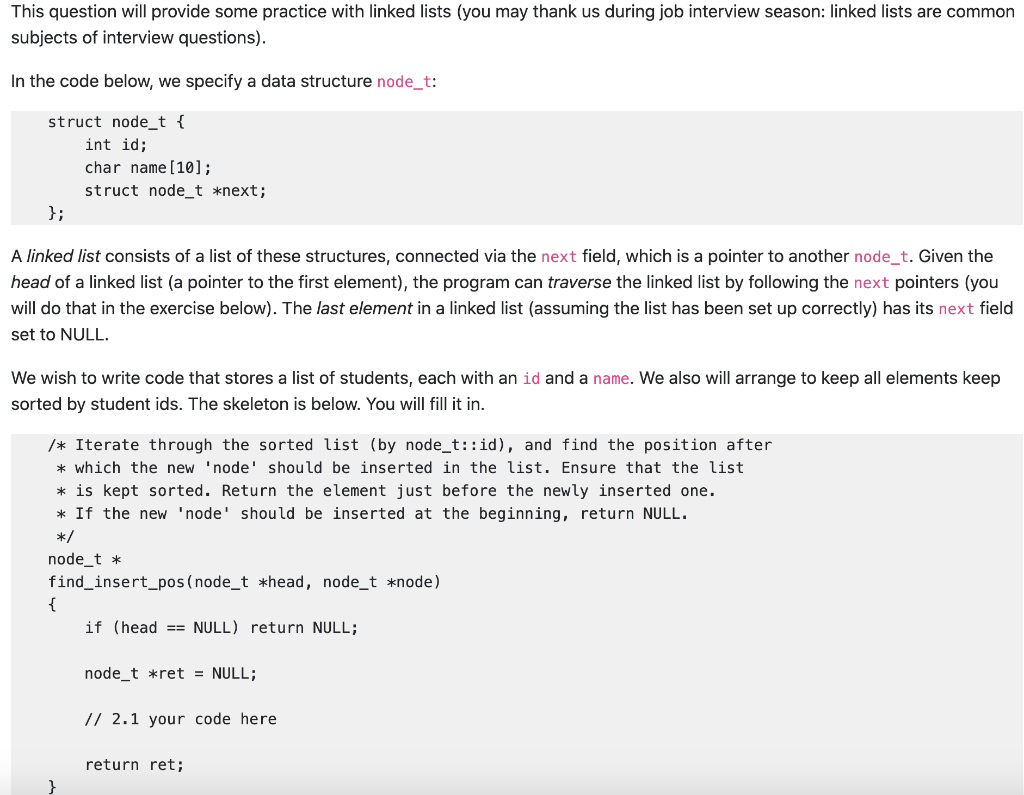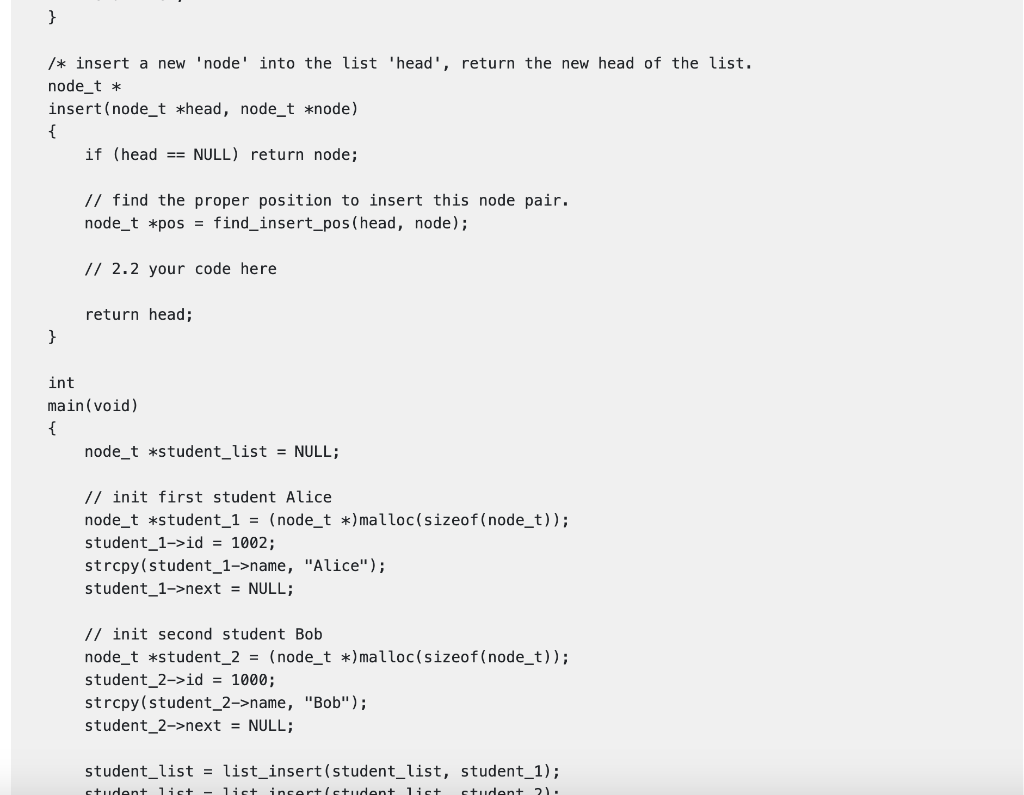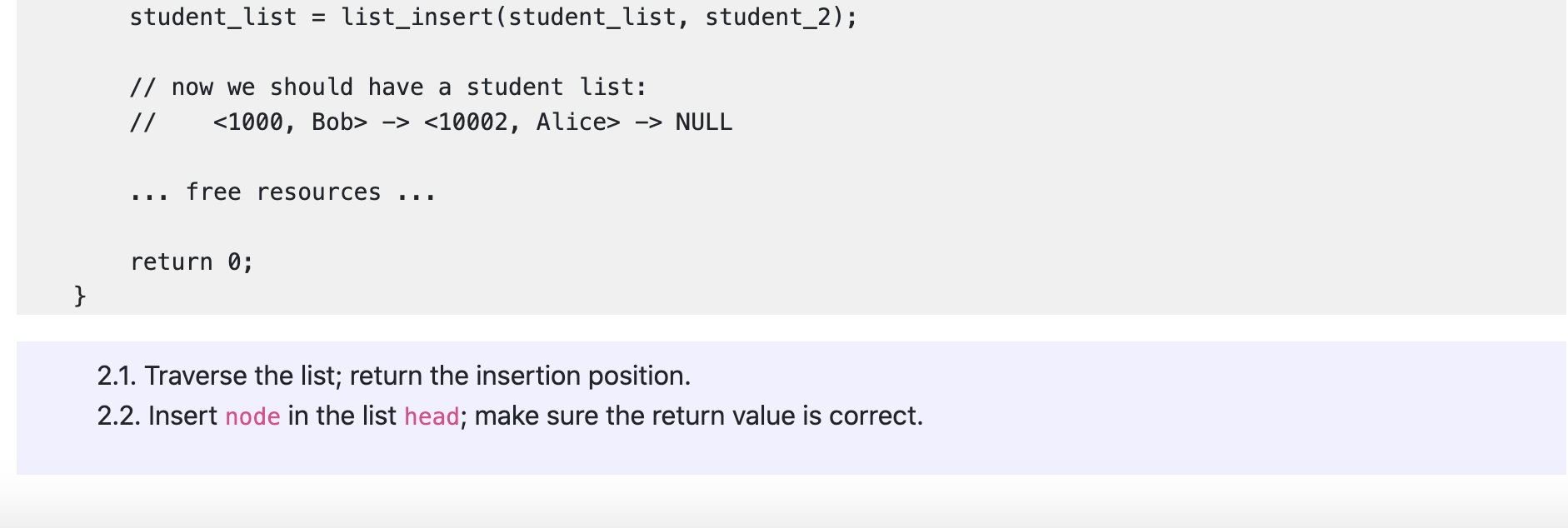


This question will provide some practice with linked lists (you may thank us during job interview season: linked lists are common subjects of interview questions). In the code below, we specify a data structure node_t: struct node_t { int id; char name [10]; struct node_t *next; }; A linked list consists of a list of these structures, connected via the next field, which is a pointer to another node_t. Given the head of a linked list (a pointer to the first element), the program can traverse the linked list by following the next pointers (you will do that in the exercise below). The last element in a linked list (assuming the list has been set up correctly) has its next field set to NULL. We wish to write code that stores a list of students, each with an id and a name. We also will arrange to keep all elements keep sorted by student ids. The skeleton is below. You will fill it in. /* Iterate through the sorted list (by node_t::id), and find the position after * which the new 'node' should be inserted in the list. Ensure that the list * is kept sorted. Return the element just before the newly inserted one. * If the new 'node' should be inserted at the beginning, return NULL. */ node_t * find_insert_pos(node_t *head, node_t *node) { if (head == NULL) return NULL; node_t *ret = NULL; 1/ 2.1 your code here return ret; } /* insert a new 'node' into the list 'head', return the new head of the list. node_t * insert(node_t *head, node_t *node) { if (head == NULL) return node; // find the proper position to insert this node pair. node_t *pos = find_insert_pos(head, node); 1/ 2.2 your code here return head; } int main(void) { node_t *student_list = NULL; // init first student Alice node_t *student_1 = (node_t *)malloc(sizeof(node_t)); student_1->id = 1002; strcpy(student_1->name, "Alice"); student_1->next = NULL; // init second student Bob node_t *student_2 = (node_t *)malloc(sizeof(node_t)); student_2->id = 1000; strcpy(student_2->name, "Bob"); student_2->next = NULL; student_list = list_insert(student_list, student_1); student liet list incerti student list student 2). student_list list_insert(student_list, student_2); // now we should have a student list: // -> -> NULL free resources return 0; } 2.1. Traverse the list; return the insertion position. 2.2. Insert node in the list head; make sure the return value is correct. This question will provide some practice with linked lists (you may thank us during job interview season: linked lists are common subjects of interview questions). In the code below, we specify a data structure node_t: struct node_t { int id; char name [10]; struct node_t *next; }; A linked list consists of a list of these structures, connected via the next field, which is a pointer to another node_t. Given the head of a linked list (a pointer to the first element), the program can traverse the linked list by following the next pointers (you will do that in the exercise below). The last element in a linked list (assuming the list has been set up correctly) has its next field set to NULL. We wish to write code that stores a list of students, each with an id and a name. We also will arrange to keep all elements keep sorted by student ids. The skeleton is below. You will fill it in. /* Iterate through the sorted list (by node_t::id), and find the position after * which the new 'node' should be inserted in the list. Ensure that the list * is kept sorted. Return the element just before the newly inserted one. * If the new 'node' should be inserted at the beginning, return NULL. */ node_t * find_insert_pos(node_t *head, node_t *node) { if (head == NULL) return NULL; node_t *ret = NULL; 1/ 2.1 your code here return ret; } /* insert a new 'node' into the list 'head', return the new head of the list. node_t * insert(node_t *head, node_t *node) { if (head == NULL) return node; // find the proper position to insert this node pair. node_t *pos = find_insert_pos(head, node); 1/ 2.2 your code here return head; } int main(void) { node_t *student_list = NULL; // init first student Alice node_t *student_1 = (node_t *)malloc(sizeof(node_t)); student_1->id = 1002; strcpy(student_1->name, "Alice"); student_1->next = NULL; // init second student Bob node_t *student_2 = (node_t *)malloc(sizeof(node_t)); student_2->id = 1000; strcpy(student_2->name, "Bob"); student_2->next = NULL; student_list = list_insert(student_list, student_1); student liet list incerti student list student 2). student_list list_insert(student_list, student_2); // now we should have a student list: // -> -> NULL free resources return 0; } 2.1. Traverse the list; return the insertion position. 2.2. Insert node in the list head; make sure the return value is correct









